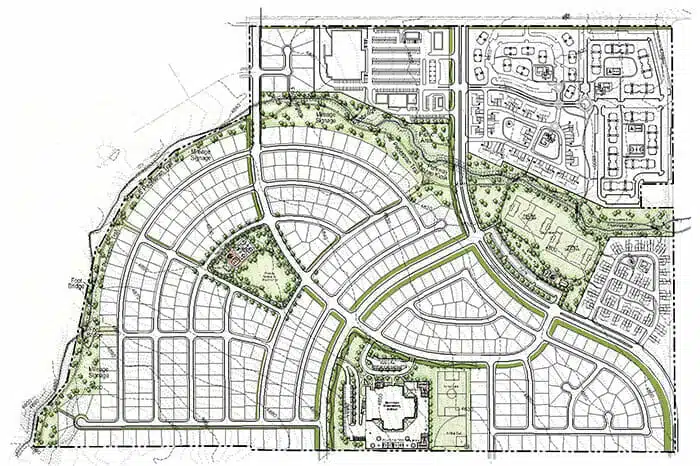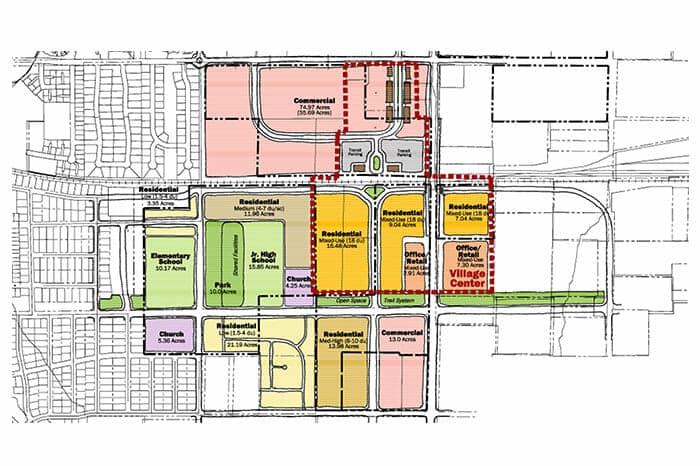 What Is Land Use Planning?
What Is Land Use Planning?
There are approximately 57,308,738 square miles of land on Earth. Of that, almost 57% is uninhabitable, leaving us with only 24,642,757 square miles to live.
In Utah, there is an average of 33.6 people per square mile of habitable land; however, over 80% of Utah’s residents live in or near Salt Lake City. Thus, despite being one of the largest states in terms of landmass, Utah is relatively sparsely populated.
These statistics highlight that land is a finite resource, and land planning developers must carefully manage its use.
The limited supply of land and resources is why land planning is critical as we develop habitable spaces for use now and to sustain future generations. Land use planning firms in Utah can help state officials when developing community and municipal projects.
Land Use Planning Definition
Land use planning is the collective effort to develop and approve a land-based project and is generally regulated by government authority. It provides the basis for our zoning laws and restricts certain uses of land in order to promote the orderly development of land in a way that protects our environment, conserves resources, promotes social gathering, enhances a community, and provides for transportation, industry, and economic needs.
What Is Land Use Planning And Development?
In every community, there are competing interests that vie for the resources of that community. Land use planning and development is the process by which community leaders allocate those resources and establish a policy for the use of land to facilitate the best land development for the general welfare of the area’s residents.
When you hire a land-use planning company, like Think Architecture, their team of Utah architects combines their experience in resource management, land planning, and landscape architecture to develop a sustainable plan that allows a piece of land to be developed to its “highest and best use.”
Why Is It Necessary To Make A Proper Plan For Land Use?
Without a proper land-use plan, cities and communities would be in disarray. Transportation would not run efficiently. Industrial plants would pollute residences, and waterways and reduce air quality. Cities would be unworkable. Communities would be unsafe. Economies would stall. The environment would be damaged and resources wasted, which would leave the area unusable for future generations.
Land planning has been around since ancient times. When people began to congregate in larger and larger groups rather than as individual nomads and in small tribes, when villages developed into larger metropolitan areas, land planning became essential to daily life.
You can still see the remnants of land zoning and development in the ruins of Greece, Rome, Mexico, Egypt, and others. This is because our ancestors recognized the benefits of having established areas to live, work, shop, manage their waste, and bury their dead.
However, it wasn’t until the 1900s that we realized just how critical land-use planning was to public health in urban areas. Poor planning in large industrial cities in the U.S., including Chicago, New York, and San Francisco, revealed that when residences were placed in close proximity to industrial areas, the spread of diseases such as tuberculosis and influenza increased, and crime rates soared.
To sum up why it’s necessary to make a proper plan for land use in a single word—usability.
The usability of the land and its resources by the community makes land planning absolutely essential for the orderly development and use of the area.
Why Is Land Use Planning Important?
In today’s society, there is a growing awareness of our impact on the environment. We understand that each of our activities leaves a carbon footprint. This growing consciousness means that we are paying attention to our living and working patterns, how they intersect, and how to live in a way that preserves the environment.
There is a burgeoning need for walkable communities, mixed-use developments, and green spaces for people to live, work and play within short distances to reduce commute times and encourage low-emission transportation options, such as walking or biking. Our land-use planning company in Utah and our Utah architects have developed many such initiatives throughout Salt Lake City and Park City, Utah.
These initiatives are for one purpose—to create a sustainable environment.
When done right, land use planning considers the needs of today and extrapolates those into what the needs of the future may be, and then creates a long-term, sustainable vision that allows the development of land that meets those needs.
Here are a few reasons land use planning is so important:
- Reduces pollutants
- Improves air and water quality
- Prevents flooding
- Promotes safe transportation and routes
- Reduces noise and light pollution
- Keeps the environment ecologically balanced
- Protects potentially endangered species
- Mitigates disaster risks
- Safeguards public health and minimizes hazards
- Maintains and improves the fiscal health of a community
- Preserves open space
- Manages growth
What Does A Land Planner Do?
When you purchase a property and plan to develop it, you should first consult with a land-use planning firm, like Think Architecture. Ideally, you would consult with a land-use planning company before purchasing to ensure that the parcel of land can be used in the way you envision.
Our land-use planners can assess the property to determine whether it meets the zoning requirements you need to develop your project and whether the soil conditions and structure of the land can accommodate the proposed development.
In addition, a land planner can work with municipalities to create comprehensive community development plans that include city parks, open spaces, city centers, community gathering spots, walking and biking trails, and more.
A land-use planner can develop and provide a vision for an entire city, a neighborhood, or even just a custom home development.
Part of the job of a land planner is to consult with a client and determine how to best convert a piece of property for either commercial or residential use. In addition, they may be responsible for conducting feasibility studies, conducting impact analyses, and determining transportation logistics.
The Land Development Planning Process
It can take years to take a project from land acquisition to completion. The land development planning process is the earliest stage of any project.
Depending on the scope of the project and the location, several steps may be involved, including:
- Market analysis and feasibility studies
- Land acquisition or securing the rights to purchase the land
- Environmental assessments
- Surveys
- Developing plans for the site, development, and any buildings
- Acquiring permits
- Financing
- Applying for rezoning*
*In some cases
These activities all occur before you even break ground on a construction project. The final stages include design iterations, project plan, infrastructure development, construction, inspections and permits, and final walkthrough.
How To Make A Land Development Plan
To create a comprehensive land development plan, rely on the expertise of an experienced land-use planning firm. Select a land planner firm in Utah that understands the nuances and various regulations that might impact your project.
Land development plans include the following considerations:
- What site constraints and opportunities are there? (Access to utilities, easements, zoning, encroachments, etc.)
- Are there environmental, hazardous, archaeological, wetlands, water rights, threatened or endangered species, or other government-related constraints?
- The project’s financing and plans for potential delays or cost increases.
- The project’s marketability
- Impact studies (traffic, stormwater run-off, water, etc.)
- Community master plans
- Timeline of reviews and permits and a flow of what’s needed
- Cost breakdown of each element
- Site plan
- Construction sequencing
- Logistics management plan
What Are The Common Types Of Land Use Planning?
In urban cities and other communities, there are different types of land use planning. However, the most common types of land use planning are the following five types:
Recreational
Recreational land is the type of spaces provided for recreational use, such as equestrian centers, parks, open spaces, golf courses, sporting fields, playgrounds, fishing ponds, and swimming pools.
Transport
This type of land is used for interstates and highways, bus stops, trains, light rail, airports, and other land needed to facilitate transportation. Municipal transportation buildings such as bus stations, subway stations, airports, and other facilities fall within this zoning type.
Agricultural
Land zoned for agricultural use may allow for growing and harvesting crops, farm buildings, fields for livestock, and other types of farm activities. Local regulations may dictate how many animals may be kept, what types can be raised, or what crops might be planted, along with pest control measures. Agricultural use often has water rights and restrictions that are included.
Residential
Residential zoning can vary based on the density and types of houses that are allowed to be built within the area. These may range from low-density single-family residences to medium-density townhomes and condominiums up to high-density multi-family apartment buildings or multi-use complexes. Multi-use or mixed-use developments that have a combination of residences, commercial buildings, and recreational spaces have a different zoning category.
Commercial
Commercial zoning allows for office buildings, warehouses, restaurants, or other commercial uses. Since there is a wide variety of commercial use, there are separate sub-designations within zoning ordinances that place restrictions on the types of commercial activity that are allowed.
Additional zoning categories and land-use planning factors include industrial, tourism, and public-use buildings, including firehouses, police stations, and hospitals. Emergency resources and their immediate availability is critical to community land-use planning.
What Are The Factors Affecting Land Use Planning?
The sheer number of factors that affect land use planning is too numerous to list here and could fill an entire college textbook. However, the primary factors that affect land use planning are:
- Sustainability
- Energy
- Social Equity
- Economy
- Livability
- Transportation
- Housing
- Environment
- Health
- Food
- Recovery
- Climate Change
As a land-use planning company develops community plans, they must also take into account future considerations:
- Changing demographics
- Lifestyles
- Potential disasters, hazards, and how to mitigate them (hurricanes, earthquakes, floods, etc.)
- Transportation types and technological advancements
- Housing improvements and advancements
- Energy conservation
- Green technology and improvements
Examples Of Land Use Planning
To view examples of land use planning in action, look at the following gallery of land planning designs by our Utah land planning firm.
Another stellar example of recreational land planning is Wardle Fields Regional Park. This project incorporated new technology to conserve and reuse water from the splash pad throughout the park.
Finally, to see an example of a mixed-use development that incorporated residential units around a corporate office building and provided recreational space on the rooftop, view the Element31 at Brickyard project.
Each of these examples shows variations of land-use planning for multiple zoning designations in Utah. To see more of our land-use planning company’s portfolio, visit Think Architecture.
How Much Does A Land Development Plan Cost?
Costs for a land development plan vary based on the project scope. A complex commercial project or large custom home development will cost more than a plan for a single-family custom home.
Most site development plans for single-family residences drawn up by a land-use planning firm will cost between $600-$1200. There will be additional costs incurred for any surveys, assessments, permits, studies, or other activities.
To get a quote on your land development plan, call the Utah architects at Think Architecture at (801) 269-0055.
How Much Does It Cost To Hire A Land Planner?
An experienced land-use planner in Utah can save you a great deal of time and money. To hire a land planner, expect to pay approximately $180-$200 an hour. Of course, call your local land-planning company in Utah to get a bid before signing any contract and discover what will be included and your final estimated cost.
Benefits Of Hiring A Professional Land Use Planner
Benjamin Franklin famously said, “if you fail to plan, you are planning to fail.”
A professional land planner will help ensure the success of your project by minimizing any upfront costs during due diligence. That is, if you want to build high-density condominiums on a piece of land zoned for single-family residences, your land planner will alert you to the zoning ordinances before you make a costly mistake on your investment.
Other benefits of hiring a professional land-use planning firm are:
- To develop a realistic plan with achievable yield assumptions
- A smooth permitting and design process
- Professional management of surveys, site analysis, and tests
- Lowered engineering costs
- Timeliness of project deadlines
- Reduced risk
- Ease to getting financing
- Maximizes land use
- Coordination of various entities, contractors, regulatory agencies, and utilities
The Value Of Using A Land Use Planner
Your time is your most valuable asset, and a land-use planner will effectively save you time on your project. When you hire a professional land planning company in Utah, they will already be familiar with local zoning laws and ordinances.
This makes the permitting and design-build process much more efficient and cost-effective in the long run. Work with Utah’s experienced land-planning company for your next construction project. We bring over 90 years of combined experience in land planning in Utah to the table.
To consult with us on your next land planning project, call us at (801) 269-0055 or contact us here.



 What Is Land Use Planning?
What Is Land Use Planning?